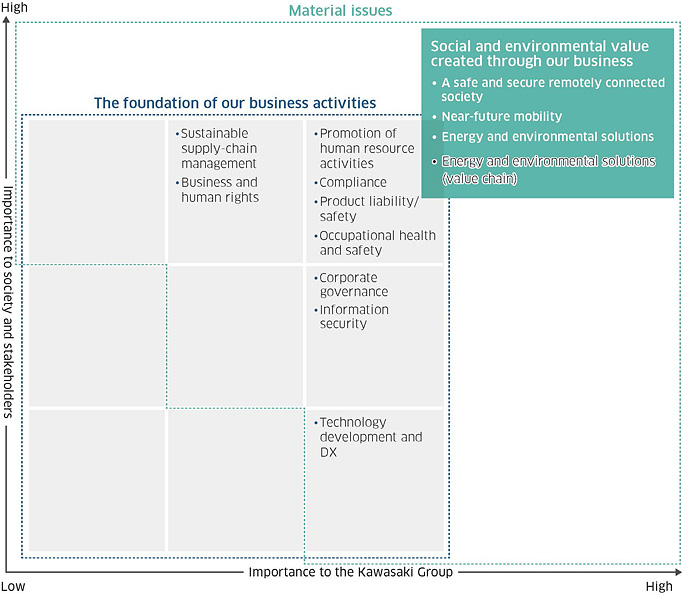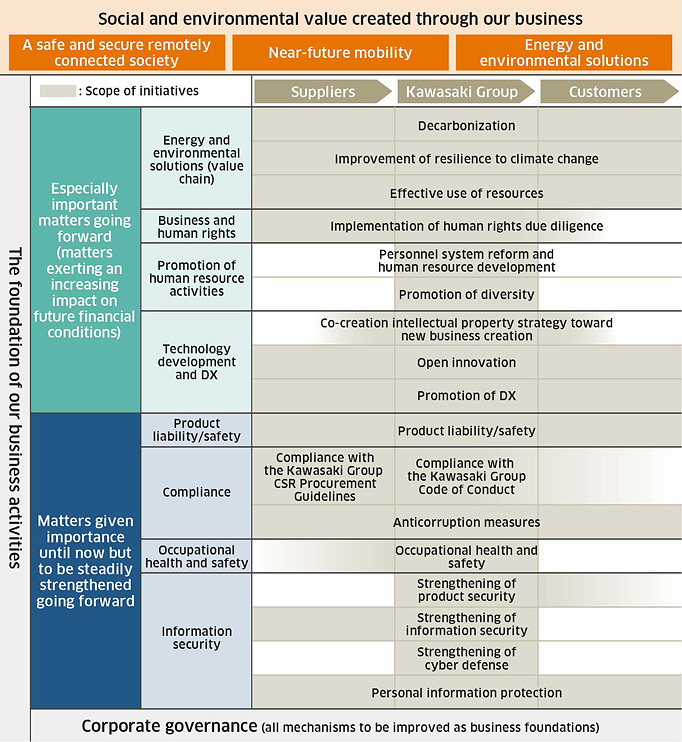Materiality
Process for Identifying Material Issues
The expectations and requirements of stakeholders are diversifying, and the business environment surrounding us is changing. In consideration of these factors, the Kawasaki Group pinpointed and arranged the impact that our Group’s business activities have on society and in 2018 identified the Kawasaki Group’s materiality.
The material issues were subsequently reevaluated following the announcement of the Group Vision 2030 in November 2020. As in 2018, we divided them into two broad categories: The “social and environmental value created through our business” and the “foundation of our business activities.” Initiatives conducted through our main business have been defined as the most material issues to be achieved by the Group over the long term, while other issues have been positioned as basic items for achieving the most material issues. Going forward, we will continue to regularly revise our material issues in accordance with changes in the business environment and expectations of society.
Summary of the Identification Process
|
Process for Identifying Material Issues
|
||
|
Step 1 |
Step 1: Revision following the formulation of Group Vision 2030 In consideration of various social issues, the Kawasaki Group’s strengths, and our envisioned image in 2030, we formulated the Group Vision 2030 in November 2020. In this vision, we stipulated the three focal fields of a safe and secure remotely connected society, near-future mobility, and energy and environmental solutions. In June 2021, after discussions in the Sustainability Committee, which is chaired by the president, these three focal fields were defined as social and environmental value created through our business. |
|
|
Step 2 |
Step 2: Revision of fundamental matters supporting our business activities In consideration of the business strategy outlined in the Group Vision 2030 and recent worldwide changes relating to sustainability, we revised the fundamental matters supporting our business activities. In making the revision, we extracted and sorted issues with reference to the survey items of ESG (environmental, social, and corporate governance) ratings institutions (the Dow Jones Sustainability Indices [DJSI], Financial Times Stock Exchange [FTSE], Morgan Stanley Capital International [MSCI], and Sustainalytics), the Sustainability Accounting Standards Board (SASB), investment stewardship, the Global Reporting Initiative (GRI), Future-Fit, self-assessment questionnaires from client companies, and the opinions of external advisors. We then compiled a provisional materiality matrix (importance to society and stakeholders and importance to the Kawasaki Group). |
|
|
Step 3 |
Step 3: Interviews with outside experts and decision on material issues We heard the opinions of outside experts and revised our materiality matrix accordingly. After discussions in the Sustainability Committee based on these opinions and the revised matrix, the Board of Directors deliberated the Kawasaki Group’s materiality and reached a final decision. |
|
|
Step 4 |
Step 4: Planning and review Regarding our identified material issues, we will aim to comply with the management approach defined under GRI standards, stipulate responsible divisions and specific numerical targets, and, through steady practice and follow-up, promote activities toward the achievement of these targets. We will report the state of progress to the Sustainability Committee and endeavor to make improvements as necessary. |
|
Comments of Experts Interviewed in Step 3
| Profile* | Expert comments (excerpt) |
|---|---|

Keisuke Takegahara
Executive Fellow and Deputy Chief Research Officer, Research Institute of Capital Formation and General Manager, Research Center on Financial Economics, Development Bank of Japan Inc. |
The Kawasaki Group has been hands-on in creating a business foundation to allow many companies to make the jump to 2030 and beyond. Because Kawasaki Group’s own transition represents the creation of innovation for other companies, discussing that scenario in the context of value creation will make it easier to gain the understanding of investors. |

Mari Yoshitaka Principal Sustainability Strategist, Mitsubishi UFJ Research and Consulting Co., Ltd. |
I would like the Company to make visible how the “foundation of our business activities” is connected to “social and environmental value created through our business,” including a time line. In the wake of the COVID-19 pandemic, investors are keeping a close eye on issues of sustainable supply chains and human rights, so these two could be elevated a bit more under social and stakeholder expectations. |

Kazuo Tase President and CEO, SDG Partners, Inc. |
The Company needs to list decarbonization and addressing TCFD among its “foundation of our business activities” issues. I think hydrogen can be considered over a somewhat longer period of time, as the technological innovations that will arise in the first half of 2030s will see the cost of hydrogen from renewable energy sources and the cost of hydrogen from fossil fuels reversed. |
* Titles are as of the time of publication.
Response to Experts’ Comments
The position of each material issue is shown in the materiality matrix. In light of the comments by experts, we amended the matrix to raise the degree of importance to society and stakeholders of “sustainable supply-chain management” and “business and human rights.”
Regarding the foundation of our business activities, in light of their comments, we classified these material issues into the following three categories and, as necessary, clarified the priority matters for each one.
(1) Items of particular importance going forward (items that will have an ever-increasing impact on future finances)
(2) Items that were emphasized in the past, but which will be steadily reinforced going forward
(3) Mechanisms to be developed as the foundation for everything
Furthermore, after taking a broad view of the flow from planning and design to product use and the whole value chain from related suppliers to customers, we clarified the scope of initiatives for each issue in categories 1 and 2 above and compiled a table of the Kawasaki Group’s materiality and priority matters. The Group’s materiality is shown in the matrix and table of priority matters.
Regarding sustainable supply-chain management, since the matters that should be addressed are wide-ranging, in the table below priority matters are shown in the “Suppliers” column.
Identified Materiality
Materiality Matrix

The Kawasaki Group’s Materiality and Priority Matters

Contact
If you need more information about our business,
please feel free to contact us.





